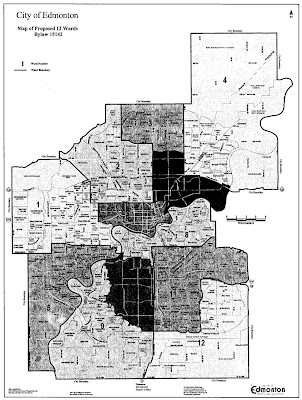Edmontonians won’t notice a difference until next fall, but if City Councillors approve Bylaw 15142: Ward Boundaries and Council Composition Bylaw on June 22, our city will shed the 6-Ward/2-Councillor system in favour of a more modern 12-Ward/1-Councillor system.
The original motion to move to the 12-Ward system was introduced by Councillors Don Iveson and Dave Theile on February 17, 2009 and was approved in first reading by Councillors on April 15, 2009 (Councillors Jane Batty, Amarjeet Sohi, Tony Caterina, and Ron Hayter voted against the motion). I attended the April 15 meeting, and while watching the debate on Ward boundary changes was as exciting as you can imagine, the meeting reached a climax when former Councillor Sheila Mckay yelled her opposition from the Chamber seating area (Mckay was calmed down by Mayor Stephen Mandel).
Why are Councillors voting for this change? A new 12-Ward system will allow Councillors to more easily manage constituent requests (smaller population to represent) and will theoretically create more equitable representation for Edmotonians (in many cases, the more high profile of the two Councillors in the current large 6-Ward system receive the lions share of the constituents requests). Overall, I think the proposed 12-Ward system would be a positive move for our City.
The proposed new boundaries largely respect natural and community league boundaries, and in most cases are simple divisions of the current 6-Ward map. It’s unfortunate that City Councillors are drawing their own electoral boundaries, which is something that should change in the future, but Edmontonians should be proud that their Councillors avoided the kind of gong show debate that recently engulfed Calgary’s City Council.
Here is the map of the proposed new boundaries:

 From a political perspective, Council will be taking a risk in accepting the new boundaries. Looking to the 2010 election, the new boundaries will likely play a factor in determining who runs for Mayor in 2010 and if any incumbents decide to run against each in the next campaign (I’m putting early odds on an Ed Gibbons versus Tony Caterina fight in the new Ward 4, and a Ben Henderson versus Jane Batty showdown in the new Ward 6).
From a political perspective, Council will be taking a risk in accepting the new boundaries. Looking to the 2010 election, the new boundaries will likely play a factor in determining who runs for Mayor in 2010 and if any incumbents decide to run against each in the next campaign (I’m putting early odds on an Ed Gibbons versus Tony Caterina fight in the new Ward 4, and a Ben Henderson versus Jane Batty showdown in the new Ward 6).
Related Links:
Better Edmonton: 12 Councillors, 12 Wards: More Than A Dozen Reasons Why…
Don Iveson: 12 Wards
SEE Magazine: Councillors stake out their territory
